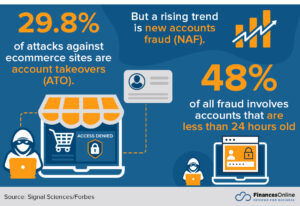In the digital age, ecommerce has become a lucrative venture, with millions of online stores popping up every year. However, with the rise of online shopping, the risk of fraud and loss has also increased exponentially. Cybercriminals are constantly on the lookout for vulnerabilities to exploit, and a single breach can result in devastating consequences for your business, including financial losses, damaged reputation, and loss of customer trust. As an ecommerce entrepreneur, it’s crucial to prioritize loss prevention and implement a comprehensive plan to shield your online store from potential threats. In this article, we’ll look into the world of ecommerce security, exploring the most common types of fraud, and providing actionable strategies to help you protect your online business from financial losses and reputational damage.
Common types of ecommerce fraud

The world of ecommerce is not without its vulnerabilities, and one of the most significant threats to online stores is fraud. As an ecommerce business owner, it’s essential to be aware of the various types of fraud that can occur, so you can take proactive measures to prevent them. Here are some common sources of loss in e-commerce:
- Financial Loss:
Payment fraud: Fraudulent credit card use, fake accounts, and unauthorized chargebacks can eat into your profits.
Inventory theft: While not a physical theft in the traditional sense, inventory discrepancies can occur due to internal errors or fraudulent orders.
Return fraud: Customers returning used or non-defective items for a full refund.
Affiliate fraud: Fraudulent affiliates use fake or stolen information to earn commissions, is also a growing concern.
Card-Not-Present (CNP) fraud: Criminals use stolen credit card information to make online purchases, is a significant threat to ecommerce businesses.
2.Data Security and Operational:
Friendly fraud: Customers makes a legitimate purchase, but then claims they never received the item or that it was damaged, in order to receive a refund.
Cybersecurity threats: Data breaches, hacking attempts, and malware infections can compromise customer information and disrupt operations.
Identity theft: Criminals use stolen credit card information or personal data to make unauthorized purchases.
Identifying vulnerabilities in your online store
As you navigate the vast landscape of ecommerce, it’s essential to acknowledge that your online store is a potential target for cybercriminals and fraudsters. Identifying vulnerabilities in your online store is a crucial step in shielding your business from potential threats. It’s like conducting a thorough security audit, where you scrutinize every nook and cranny of your website, searching for weaknesses that could be exploited by malicious actors. From outdated plugins and software to inadequate password protection, weak encryption, and unsecured payment gateways, there are numerous potential vulnerabilities that could leave your online store exposed. To identify these vulnerabilities, you’ll need to adopt a proactive approach, regularly monitoring your website’s performance, analyzing customer feedback, and staying up-to-date with the latest security patches and best practices.
Implementing a comprehensive loss prevention plan
Implementing a comprehensive loss prevention plan is a crucial step in safeguarding your ecommerce business from the devastating effects of fraud, theft, and other forms of financial loss. It’s a multifaceted approach that requires careful consideration of every aspect of your online store, from payment processing to inventory management. A well-thought-out plan will not only help you identify and mitigate potential risks, but also provide a framework for responding to losses when they do occur. Integrating fraud detection tools, monitoring shipping and delivery, and establishing clear policies for returns and refunds, can significantly reduce the likelihood of losses and protect your business’s bottom line. Additionally, implementing a comprehensive loss prevention plan will also help you to build trust with your customers, improve your overall operations, and ultimately, drive long-term success for your ecommerce business.
Strategies for preventing fraud and loss
In the world of ecommerce, fraud and loss can be a constant threat to your online store’s success. One minute, you’re celebrating a successful sale, the next, you’re dealing with a fraudulent chargeback. To shield your online store from these types of losses, it’s essential to implement a comprehensive loss prevention plan that proactively detects and prevents fraudulent activity. Let’s delve into strategies to mitigate them:
- Secure your website and data:
HTTPS encryption: Implement a secure socket layer (SSL) certificate to encrypt data transmission between your website and customers’ browsers. This protects sensitive information like credit card details.
Strong password policies: Enforce strong password requirements for both customer accounts and administrative access. Regularly update passwords to minimize the risk of unauthorized access.
Fraud detection tools: Utilize fraud detection software that analyzes transactions for suspicious activity. These tools flag potentially fraudulent orders based on factors like billing address inconsistencies or unusual purchase patterns.
Payment gateway security: Partner with a reputable payment gateway that offers robust security features and fraud prevention tools. These providers handle sensitive financial information and provide additional layers of protection.
- Implement access controls and user permissions:
Limit access: Restrict access to sensitive information and administrative areas of your website to authorized personnel only. Implement user roles and permissions to control what users can see and do within your e-commerce platform.
Regular monitoring: Monitor employee activity logs and access attempts to detect any suspicious behavior.
- Secure your inventory management:
Accurate inventory records: Maintain accurate and up-to-date inventory records to minimize discrepancies. Regularly conduct inventory audits to identify any potential shrinkage.
Order verification: Implement order verification procedures, especially for high-value items, to confirm order legitimacy before processing.
Warehouse security: If you manage your own warehouse, ensure proper physical security measures are in place, such as limited access control, security cameras, and alarm systems.
- Implement secure payment processing:
PCI compliance: Ensure your e-commerce platform and payment processing system comply with Payment Card Industry Data Security Standards (PCI DSS). PCI DSS outlines best practices for protecting customer credit card information.
Tokenization: Consider tokenization solutions that replace customer credit card information with unique tokens during transactions. This minimizes the risk of data breaches even if hackers gain access to your system.
- Minimize friendly fraud and return fraud:
Clear return policy: Clearly outline your return policy on your website. This policy should define eligible return items, acceptable return windows, and restocking fees, if applicable.
Detailed product descriptions and images: Provide detailed product descriptions and high-quality images to ensure customers understand exactly what they are purchasing. This minimizes the chances of receiving returns due to unmet expectations.
Customer reviews and ratings: Encourage customer reviews and ratings to provide potential buyers with additional information about your products. Positive reviews can build trust and reduce the likelihood of fraudulent returns.
- Prioritize customer service:
Responsive customer support: Offer responsive customer support to address customer inquiries and concerns promptly. This can help resolve disputes and minimize friendly fraud.
Order tracking: Provide customers with order tracking capabilities to monitor the status of their purchases. This transparency helps build trust and reduces anxiety that might lead to unnecessary chargebacks.
- Stay informed and adapt:
Industry best practices: Stay updated on the latest e-commerce security threats and industry best practices for loss prevention.
Regular reviews: Regularly review your loss prevention plan and adapt it as your business evolves and new threats emerge.
Security audits: Consider conducting periodic security audits to identify vulnerabilities in your systems and processes. These audits can be performed internally or by a qualified security professional.
- Employee training:
Security awareness: Educate your employees about security best practices. This includes training on identifying phishing attempts, password security, and data handling procedures.
Empower employees: Empower your employees to report suspicious activity. Encourage them to be vigilant and flag any potential security risks they encounter.
The benefits of a robust loss prevention plan
Investing in a comprehensive loss prevention plan offers numerous benefits for your e-commerce business:
Reduced financial losses: By mitigating threats like fraud and theft, you can protect your profits and ensure the financial viability of your business.
Enhanced customer trust: Strong security measures and a commitment to data protection build trust with customers, encouraging them to shop with confidence on your platform.
Improved operational efficiency: Effective loss prevention strategies can streamline order fulfillment and minimize returns, leading to improved operational efficiency.
Peace of mind: Knowing you have a robust plan in place to safeguard your business from security threats provides peace of mind, allowing you to focus on growing your online store.
Best practices for maintaining ecommerce security
When it comes to maintaining ecommerce security, it’s essential to stay vigilant and proactive in protecting your online store from potential threats. One of the best practices is to keep your software and plugins up-to-date, as outdated versions can leave you vulnerable to attacks. Regularly monitor your website’s performance and watch for any suspicious activity, such as unusual login attempts or strange payment processing. Implementing a strong password policy and enabling two-factor authentication can also help prevent unauthorized access to your site. Additionally, use trusted payment gateways and ensure that your website has an SSL certificate, which encrypts sensitive customer data and helps to build trust with your customers. Furthermore, limiting access to sensitive areas of your website and implementing a secure checkout process can also help to prevent fraudulent activities.
E-commerce fraud on the rise: 2024 statistics signal growing threat

E-commerce fraud continues to be a significant threat to online businesses in 2024. Statistics paint a concerning picture, with estimates suggesting global losses could surpass $48 billion this year. This marks a sharp increase from previous years, highlighting the growing sophistication of cybercriminals targeting online stores. Payment fraud remains the most common culprit, encompassing stolen credit card use, fake accounts, and unauthorized chargebacks. These fraudulent transactions can eat away at profits and damage a business’s reputation. Beyond financial losses, e-commerce businesses also face challenges from return fraud, where customers exploit return policies, and inventory theft, where discrepancies arise due to internal errors or fraudulent orders.
Conclusion
As you’ve seen, the world of ecommerce is fraught with potential pitfalls and threats to your online store’s success. From fraudulent transactions to inventory discrepancies, the risks are real and can be devastating to your bottom line. But with a comprehensive loss prevention plan in place, you can shield your online store from these dangers and ensure a secure and profitable future. Don’t let the threats of fraud, theft, and inventory loss hold you back from achieving ecommerce success. Take control of your online store’s security today and reap the rewards of a safe and thriving online business.


Embrace transparency in all business dealings to foster a positive reputation and build enduring relationships with customers and stakeholders.
Thank you for your insightful comment.
At Selly Africa, we fully agree that transparency is key to building trust and fostering strong, long-lasting relationships with customers and stakeholders. We are committed to maintaining open and honest communication in all our business dealings, ensuring that our customers feel valued and informed every step of the way. We aim to create a positive business environment where trust and accountability are at the forefront of everything we do. Your feedback encourages us to continue striving for excellence in this area
Thank You,
Selly Africa